What can a Brain Map tell us?
Neurofeedback London uses proprietary software, developed by founders of the field and the most advanced method of analysis.
Daniel Webster is a student of various founders of the field of neurofeedback, and uses advanced brain mapping technology. This method is the most advanced due to the experience and data gathered by scientists since inception of the field, and their proprietary analysis methodology.
The Kaiser Neuromap is unique due to its:
– revelation of traits, rather than temporary states of mind
– database of functional, motivated minds used for reference, rather than averages of clinical populations
– insights into contribution and integration of brain areas, both intra-cortical and thalamo-cortical
– identification of neuromarkers
– differentiation between functional brain areas per the Brodmann Atlas, and insights into their higher-order functions
– tested reliability with over 3,000 brain maps
Daniel performs brain maps at the client’s premises to ensure a comfortable, familiar environment, as well as in clinic and practice rooms.
Phone +44 (0)7966699430 or email neurofeedbackdw@proton.me to arrange.
Neurofeedback training provides a complementary approach to mental health.
We are exercising the pre-conscious mind and showing it more efficient ways of sensory processing, all in a non-invasive, medication-free way.
The process involves watching movies, receiving auditory feedback and passively letting the brain learn new behaviour.
We can train our brain to be more stable, flexible and adaptive.
This has shown to be effective for ADHD, depression, trauma, autism and neuro-degenerative conditions, among many other mental health issues.
A brain map provides a guide to traits, strengths and vulnerabilities. We can work on these in many ways, including neurofeedback training. It can also be useful for us to be aware of these attributes, bearing in mind that with a brain map, we see how we are preconsciously ‘wired’.
It might show us for which aspects we are having to use conscious energy to overcome inefficiencies or undesirable tendencies.
Ideally, we would like to reduce such conscious effort to free up resources and live in the moment.
Neurofeedback enables us to train specific brain areas and improve their contribution.
A Brain Map provides the starting point for Personalised Brain Training, an advanced neurofeedback training method.
Contact Daniel on +44 (0)7966 699430 or neurofeedbackdw@proton.me to arrange.
Quick Navigation
Brain Maps and Personalised Brain Training Explained
Personalised Brain Training with Neurofeedback
Neurofeedback lets us train dysrythmic brain areas. With sensors comfortably fitted to the brain areas we want to train, we detect brainwave patterns real-time while watching a movie. When these patterns are inefficient, the volume drops momentarily. This is the feedback we are giving our brain, short and instantaneously.
The brain area we are training recognises this – while our conscious mind is focussed on the movie – and adjusts its behaviour to restore the normal volume. With repetition, throughout a session, learning occurs.
Meanwhile our conscious mind is solely focussed on the movie; the training process is passive in this sense.
The drop in volume is subtle, so we continue to understand the flow of the movie. No current or electrical stimulation is fed to the brain; sensors simply read brainwaves and the feedback is purely audio-visual.
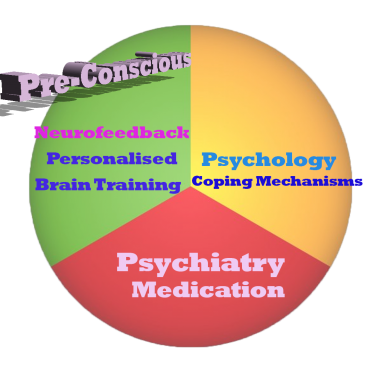
Neurofeedback trains our Pre-Conscious Mind
Rather than engaging the conscious mind, which slows us down, we are training preconscious processes.
This equips us with the ability to live in the moment and attain our potential (if we have to resort to conscious control, we are not living in the moment).
We take a holistic approach to healthy brain self-regulation, rather than categorisation or diagnosis.
Personalised Brain Training is an advanced qEEG brain map-based approach to neurofeedback training developed by the founders of the field. Taking Othmer Method / ILF training methods further, it employs Default Network Training protocols as developed by David Kaiser.
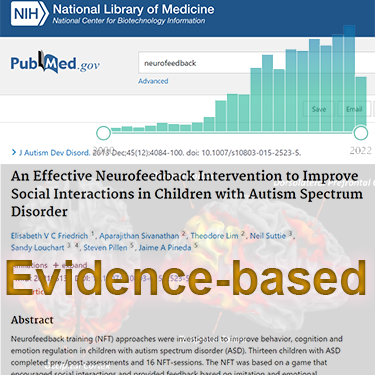
Neurofeedback is Evidence-based
Neurofeedback training is an evidence-based complementary therapy. Its efficacy was first demonstrated some 50 years ago, and with advances in technology, training protocols have become more efficient and the feedback method – watching movies – thoroughly enjoyable.
Neurofeedback is evidence-based. It’s first application was discovered in 1971 when it was used to resolve intractable epilepsy.
There are over 2,000 peer-reviewed research reports on PubMed demonstrating efficacy across a number of pathologies.
In the US, it is an accepted complementary treatment for many challenges.
Kaiser Neuromap and Neurofeedback
Neurofeedback training can benefit anyone.
Children, Teenagers and Young Adults: We can assess and assist cortical maturation; improve academic performance, social integration and behaviour; eliminate fear and anxiety to further self-confidence, and relaunch positive developmental trajectories.
Adults: Stress, anxiety, trauma, mood regulation, motivation, focus and sleep
Psychosis: Neurofeedback provides a safe, medication-free approach to restoring calm and confidence, and alleviating symptoms in Schizophrenia
Autism: an evidence-based approach to improving cognitive flexibility, sensory integration, behaviour and social interaction.
Rehabilitation: symptoms demonstrably improve in stroke / TBI, and neurodegenerative disorders such as Alzheimer’s, Parkinson’s and Multiple Sclerosis. Brain maps can identify functional connectivity issues that are otherwise difficult to observe or measure. Neurofeedback has been shown to strengthen white matter.
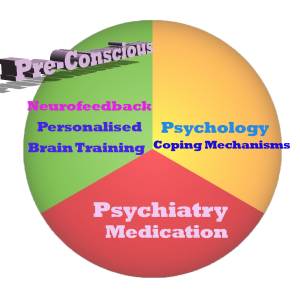
Neurofeedback training provides a complementary approach to mental health.
We are exercising the pre-conscious mind and showing it more efficient ways of sensory processing, all in a non-invasive, medication-free way.
The process involves watching movies, receiving auditory feedback and passively letting the brain learn new behaviour.
We can train our brain to be more stable, flexible and adaptive.
This has shown to be effective for ADHD, depression, trauma, autism and neuro-degenerative conditions, among many other mental health issues.

Brain maps show us the level of maturity and integration of the important brain areas and neural hubs which underpin the networks activated over the spectrum of our physiological activity. These processes are largely preconscious, so we learn about how we are ‘wired’, before conscious energy comes into play.
Ideally, we would like these all to work together smoothly, thus enabling us to live in the moment and use our conscious thoughts efficiently. Once identified, we can train brain areas with neurofeedback training.

Important strengths and vulnerabilities of personality and behaviour that can be identified with a brain map include:
– Sensory Integration: The speed with which we sample our environment is measured by our resting alpha, the dominant rhythm when the brain is in self-referential activity, with minimal sensory input. We would like this rhythm to be consistent across brain areas and at a level that enables us to optimally synchronize with our environment
![]()
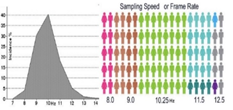
– Perception of Self and Others: Dysrhythmia in the brain areas responsible for our sense of self and appreciation of others can lead to anxiety, anger and frustration.
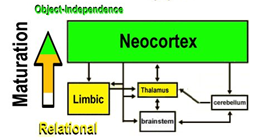
– Egocentricity and Relational Thinking: Our sense of balance for how we fit into our external world can become skewed through extensive isolation, lack of social integration (and socialising), and other trauma. This can make us overly sensitive to external stimuli, and over-priming our instinct and environment diminish our true sense of agency, which can result in anxiety and depression among other
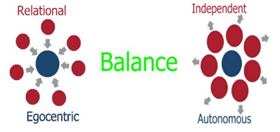
– Sleep: Quality of and ability to fall asleep are a function of two major neural hubs, which are also responsible for our feelings of safety and nurture, fairness and sharing
– Motivation and Reward: Our ability to monitor the consequences of our actions, as well as to self-soothe and re-direct goal-oriented behavior is governed by distinct sites and networks
– Focus and Organisation: Task-switching, impulsivity, attention, internal organisation
– Stress Response: Identification of trauma, and response to verbal, emotional and social stimuli
– Personal and Social Boundaries: Invasiveness vs. manipulation, tendencies for aggressiveness or self-harmful behaviour, self-esteem and frustration
– Developmental: Neuromarkers for autism, schizophrenia, ADHD, depression (and bipolar disorder), and many other pathologies and disorders
– Lateral and Integrative Imbalances: Differences between homologues (contralateral sites), and between state-dependent performance indicators show us how a person responds to new versus familiar environments, and how their public persona relates to their private, personal life
The Advantages of a qEEG Brain Map
Our Brain is the organ we last gained the ability to look into, despite it’s greatest importance. There are many methods to observe the brain’s activity in situ, and the arguably best method is qEEG:
– Quick and Easy: a comfortable cap is fitted with conducting gel, and three short three-minute readings, eyes open and then eyes closed, are recorded. The process usually takes 30-45 minutes from fitting to finish.
– Non-invasive: We are only concerned with signals sensed on the surface of the head and need not make any physical intervention apart from fitting the cap with discrete applications of a conductive gel that washes out easily.
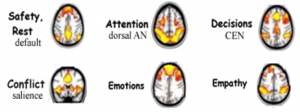
– Informative: With proprietary analysis, we can determine which brain areas are contributing optimally, and which ones are over- or underconnected. This adds an additional dimension over many other methods.
– Trait vs. State: Again using proprietary analysis, we can trace underlying attributes – traits – that are of deeper concern than momentary observations of state.
– Reliable Guide to a Healthy Brain: Analysing results relative to a proprietary sample universe of high-functioning, motivated adults and children provides above-average guidance for optimal brain connectivity.